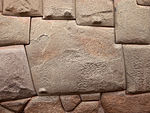Ruka (house type)

A ruka or ruca is a traditional Mapuche house type. Rukas were originally round with a conical roof. Rucas are typically built communally. Rukas traditionally lack windows and are made up a single open space in the interior.[1] The interior of the rukas are organized around a central fireplace.[1]
Travellers in the first half of the 20th century compared the housing conditions of rukas favourably to the tenements of Santiago and the countryside cottages of non-Mapuche Chilean farmers.[1]
Overview
[edit]This article may be a rough translation from Spanish. It may have been generated, in whole or in part, by a computer or by a translator without dual proficiency. (July 2024) |
The ruca is the most important building in Mapuche architecture, where they live traditionally. Ruca, in Mapudugun, means "house".
Its area varies between 120 and 240 square meters. This construction is based on the materials provided by the surrounding land. For example: They are formed of planks or poles of coligüe, reinforced on the inside with wooden posts, and covered with tule. The roof is of junquillo or of some grass similar to Peruvian feathergrass (paja brava).
The traditional ruca is round or oval, or it can also be rectangular or square, and it has one principal entrance which faces East, expressing the Mapuche cosmological preference for Pwelmapu or Puel mapu, their eastern homelands. It can also have a small secondary entrance to the west.
Within, there are spaces for keeping provisions, and domestic artifacts generally hang from the walls and ceiling. There are beds to the sides, and the center is the hearth or kütralwe, which serves to cook food and for lighting, heat, and as a place of food preparation, and also for waterproofing: the smoke, carrying grease from foods, coats the interior of the house over time in a protective layer. The carbon and soot darken the interior walls and give a particular scent to the environment of the ruca; the smoke leaves through a hole in the roof. The kütralwe or hearth burns constantly in the center of the house, and is the home of Ngen-kütral, or the Mapuche fire spirit.[citation needed]
Construction
[edit]Historically, when they wanted to construct a ruca, a Mapuche would request permission from the spirit Ngen-mapu so as to establish themself in this place, and they would notify a superior to inform the rest of the community. Thus, the future owner of the ruca would gather the necessary materials, while the people of the community would join in working to raise the ruca, a common labor known as rukatun or rukan.
To finish the work, there is a celebration with food prepared by the collaborators, and dancing with masks made from wood or collón.[citation needed]
References
[edit]- ^ a b c "Ruka: representación arquitectónica y simbólica del mundo mapuche". Museo Mapuche de Cañete (in Spanish). Retrieved 2021-06-23.


